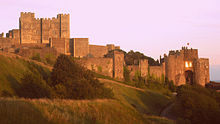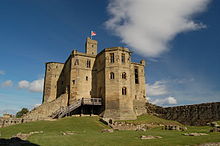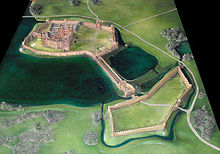|
John Goodall's The English Castle and delving into castle editing |
- By Hchc2009

The outside of John Goodall's The English Castle accurately reflects what you get inside. This is a huge slab of a volume, almost too heavy to hold easily, with 549 pages of text and colour plates. In many ways it is a cross between an academic work and a coffee table book: this is a book on military fortifications to be savoured. The text is richly decorated with maps, plans, modern reconstructions and old documents and prints. It looks gorgeous.
But what does it tell us? If you know the recent literature on British castles, you'll be aware that in the 1980 and 1990s there was something of a revolution in castle studies. The old paradigm of focusing on an evolutionary story of military castle design, starting in the motte and bailey fortifications of the 1060s and culminating in the Edwardian über-castles of the late 1290s, was supplanted by a focus on the cultural and social interpretations of the fortifications. There was an increased interest in castle landscapes, with fresh research into timber castles, earthworks and the use of water.
Goodall provides a solid introduction into these changes early in his book, and it makes for a decent summary. What follows, though, is a relatively conservative focus on the architecture of England's castles. John Goodall is an architectural historian and it shows: he presents a story about the stone bones of England's castles, with little interest in many of the more recent trends in castology. The castles that interest most Goodall are the big ones: Kenilworth, Windsor, Durham and their ilk, and he presents them well. His exploration of the links between ecclesiastical and military architecture are the most innovative parts of the book; his coverage of the smaller, lesser castles the least imaginative. Goodall's story ends with the English Civil War and the slighting of some of his favourite dwellings - which is a pity, as I think I would have enjoyed reading his analysis of the 19th century vogue for fake Norman castles.
How does our Wikipedia compare to Goodall? Generally speaking, not badly. The Featured Articles on castles generally stack up somewhat better than Goodall's depiction - they cover a wider range of the literature, and can often read better. The English Castle covers a much wider number of castles, of course, and, particularly, once we're off the beaten track of the Good Articles in the Fortification Task Force, Goodall romps home on these.
So, you've read The English Castle review and fancy writing your own article? Here's a quick guide for anyone wishing to develop an article on their favourite castle, or running a college project etc.:

1) Check out the Gatehouse
Check out Philip Davis's website The Gatehouse. Davis is held in high esteem by the castle community, and his website usefully brings together a whole set of links and information on castles in the UK, including a helpful bibliography for each of them. Invaluable for getting started on a project.
2) Check the Victorian wikipedia
Back at the start of the last century, the Wikipedians of the day came together to create the Victoria County History (VCH) of England. This was a hundred years ago or so ago, and it still isn't completed, but a lot of their material is online, some of their early works are now out of copyright, and it can be a really good source of narrative history for selected castles. Definitely worth checking out.
3) Check the reports
There is quite a lot of reports and archaeological info out there on the web. Try Pastscape, hosted by the National Monuments Record, which has material on many sites. English Heritage sometimes publish archaeological reports and research summaries of particular locations; if there's one available, it will usually give a decent literature overview and and up to date account of current analysis - these are typically written by their newer research staff as far as I can tell, and tend to be really good. English Heritage also regularly publish an authoritative "at risk" listing as part of their role in the UK government; if the castle concerned is at risk from poor maintenance, this will give you an indication of the current condition and the specific risk factors, which will bring an article easily up to date. Local authorities also typically publish material under the heading of Historical Environmental Records; these HERs can be searched through the Heritage Gateway website.
3) Find a ground-plan
A plan of a castle will usually add quite a lot for the typical reader - although in academic circles, an uncritical use of these can be frowned upon. Unfortunately, they can be tricky to find. Some well-surveyed castles will have 19th century or early 20th century plans that can be used (but do check the date when their author died, particularly if first published in the UK - some "copyright free" material on the web is not copyright free in the UK). Some Victoria County Histories may have useful, out-of-copyright plans of earthworks too. It can be worth perusing Crown Copyright plans, often produced by the Department of Works and others for early guidebooks; Crown Copyright in the UK typically expires after fifty years, and many of these are steadily becoming available. As a last resort, consider drawing your own; Inkscape and similar free tools will allow a pretty professional version of a castle plan to be produced while respecting the copyright of the original depiction.
4) Check for law enforcement usage
Many castles in England, particularly those used by county sheriffs, continued to be used as gaols up until the 19th century. Usually you'll find a record of their condition in John Howard's recorded inspections in the 1770s and 1780s, which are widely available on-line and can be useful.
5) Find some pictures

If you're looking for pictures, then Flickr can be a useful source for popular sites. It's also worth looking on Geograph, which aims to document the whole of the UK on a Creative Commons license basis. John Speed's county maps from 1610 often include a picture of the local castle; these are widely available in the public domain, and can be cropped down to size to illustrate an article. There is a right of panorama in the UK, which means that you can take photographs relatively freely, and in particular you can usually apply this right to the 3-D models of castles that many museums have. Taken up close and trimmed slightly, the results can look excellent - as seen here. Don't be tempted to photograph the 2-D reconstruction pictures you'll see at various sites, museums and guidebooks though. They're not covered by the right of panorama and are very expensive works of art to produce: their owners will quite rightly get a little upset at casual copyright fraud... :)
5) Check a gazetteer If you're doing much work on castles, a decent castle gazetteer by a reliable academic is invaluable as a starting point. I quite like Adrian Pettifer's works, such as this one, Castles: a Guide by Counties, but there are many others.
6) Look for a guidebook
It's almost always acquiring a guidebook for the castle if possible. The various regional heritage departments in the UK - English Heritage, Cadw, Historic Scotland - have each evolved a distinctive "house style" for their publications. Don't treat these uncritically, though; while typically produced by leading academics, these are commercial publications, designed for the general public, and you will often find that they focus on a handful of "key periods" or events in a castle's life at the expense of others, in an attempt to produce an accessible narrative.
7) There be dragons
Like many academic fields, the interpretation of castles changes over time. Read a late Victorian text, and you'll find some castles being dated to the Anglo-Saxon period, for example: the link between castles and the Norman conquest wasn't firmed up until 1912. Fresh archaeological work can substantially change interpretations of particular buildings and fresh perspectives alter academic views considerably. While older sources have their uses - 19th century Victorian narrative sources often contain details unavailable elsewhere, for example - don't use them uncritically.
|
|
John Goodall's The English Castle and delving into castle editing |
- By Hchc2009

The outside of John Goodall's The English Castle accurately reflects what you get inside. This is a huge slab of a volume, almost too heavy to hold easily, with 549 pages of text and colour plates. In many ways it is a cross between an academic work and a coffee table book: this is a book on military fortifications to be savoured. The text is richly decorated with maps, plans, modern reconstructions and old documents and prints. It looks gorgeous.
But what does it tell us? If you know the recent literature on British castles, you'll be aware that in the 1980 and 1990s there was something of a revolution in castle studies. The old paradigm of focusing on an evolutionary story of military castle design, starting in the motte and bailey fortifications of the 1060s and culminating in the Edwardian über-castles of the late 1290s, was supplanted by a focus on the cultural and social interpretations of the fortifications. There was an increased interest in castle landscapes, with fresh research into timber castles, earthworks and the use of water.
Goodall provides a solid introduction into these changes early in his book, and it makes for a decent summary. What follows, though, is a relatively conservative focus on the architecture of England's castles. John Goodall is an architectural historian and it shows: he presents a story about the stone bones of England's castles, with little interest in many of the more recent trends in castology. The castles that interest most Goodall are the big ones: Kenilworth, Windsor, Durham and their ilk, and he presents them well. His exploration of the links between ecclesiastical and military architecture are the most innovative parts of the book; his coverage of the smaller, lesser castles the least imaginative. Goodall's story ends with the English Civil War and the slighting of some of his favourite dwellings - which is a pity, as I think I would have enjoyed reading his analysis of the 19th century vogue for fake Norman castles.
How does our Wikipedia compare to Goodall? Generally speaking, not badly. The Featured Articles on castles generally stack up somewhat better than Goodall's depiction - they cover a wider range of the literature, and can often read better. The English Castle covers a much wider number of castles, of course, and, particularly, once we're off the beaten track of the Good Articles in the Fortification Task Force, Goodall romps home on these.
So, you've read The English Castle review and fancy writing your own article? Here's a quick guide for anyone wishing to develop an article on their favourite castle, or running a college project etc.:

1) Check out the Gatehouse
Check out Philip Davis's website The Gatehouse. Davis is held in high esteem by the castle community, and his website usefully brings together a whole set of links and information on castles in the UK, including a helpful bibliography for each of them. Invaluable for getting started on a project.
2) Check the Victorian wikipedia
Back at the start of the last century, the Wikipedians of the day came together to create the Victoria County History (VCH) of England. This was a hundred years ago or so ago, and it still isn't completed, but a lot of their material is online, some of their early works are now out of copyright, and it can be a really good source of narrative history for selected castles. Definitely worth checking out.
3) Check the reports
There is quite a lot of reports and archaeological info out there on the web. Try Pastscape, hosted by the National Monuments Record, which has material on many sites. English Heritage sometimes publish archaeological reports and research summaries of particular locations; if there's one available, it will usually give a decent literature overview and and up to date account of current analysis - these are typically written by their newer research staff as far as I can tell, and tend to be really good. English Heritage also regularly publish an authoritative "at risk" listing as part of their role in the UK government; if the castle concerned is at risk from poor maintenance, this will give you an indication of the current condition and the specific risk factors, which will bring an article easily up to date. Local authorities also typically publish material under the heading of Historical Environmental Records; these HERs can be searched through the Heritage Gateway website.
3) Find a ground-plan
A plan of a castle will usually add quite a lot for the typical reader - although in academic circles, an uncritical use of these can be frowned upon. Unfortunately, they can be tricky to find. Some well-surveyed castles will have 19th century or early 20th century plans that can be used (but do check the date when their author died, particularly if first published in the UK - some "copyright free" material on the web is not copyright free in the UK). Some Victoria County Histories may have useful, out-of-copyright plans of earthworks too. It can be worth perusing Crown Copyright plans, often produced by the Department of Works and others for early guidebooks; Crown Copyright in the UK typically expires after fifty years, and many of these are steadily becoming available. As a last resort, consider drawing your own; Inkscape and similar free tools will allow a pretty professional version of a castle plan to be produced while respecting the copyright of the original depiction.
4) Check for law enforcement usage
Many castles in England, particularly those used by county sheriffs, continued to be used as gaols up until the 19th century. Usually you'll find a record of their condition in John Howard's recorded inspections in the 1770s and 1780s, which are widely available on-line and can be useful.
5) Find some pictures

If you're looking for pictures, then Flickr can be a useful source for popular sites. It's also worth looking on Geograph, which aims to document the whole of the UK on a Creative Commons license basis. John Speed's county maps from 1610 often include a picture of the local castle; these are widely available in the public domain, and can be cropped down to size to illustrate an article. There is a right of panorama in the UK, which means that you can take photographs relatively freely, and in particular you can usually apply this right to the 3-D models of castles that many museums have. Taken up close and trimmed slightly, the results can look excellent - as seen here. Don't be tempted to photograph the 2-D reconstruction pictures you'll see at various sites, museums and guidebooks though. They're not covered by the right of panorama and are very expensive works of art to produce: their owners will quite rightly get a little upset at casual copyright fraud... :)
5) Check a gazetteer If you're doing much work on castles, a decent castle gazetteer by a reliable academic is invaluable as a starting point. I quite like Adrian Pettifer's works, such as this one, Castles: a Guide by Counties, but there are many others.
6) Look for a guidebook
It's almost always acquiring a guidebook for the castle if possible. The various regional heritage departments in the UK - English Heritage, Cadw, Historic Scotland - have each evolved a distinctive "house style" for their publications. Don't treat these uncritically, though; while typically produced by leading academics, these are commercial publications, designed for the general public, and you will often find that they focus on a handful of "key periods" or events in a castle's life at the expense of others, in an attempt to produce an accessible narrative.
7) There be dragons
Like many academic fields, the interpretation of castles changes over time. Read a late Victorian text, and you'll find some castles being dated to the Anglo-Saxon period, for example: the link between castles and the Norman conquest wasn't firmed up until 1912. Fresh archaeological work can substantially change interpretations of particular buildings and fresh perspectives alter academic views considerably. While older sources have their uses - 19th century Victorian narrative sources often contain details unavailable elsewhere, for example - don't use them uncritically.
|

